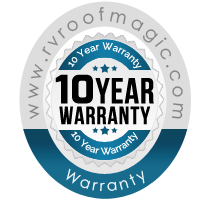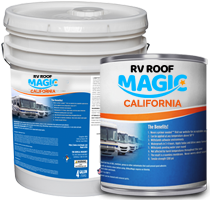For maximum performance and overall service life for your RV, inspect your roof regularly. Also, keep the roof clean and free of oils and debris to give you maximum years of protection and performance. Touch up any damaged areas caused by branches or limbs immediately to prevent additional substrate deterioration.
CAUTION: RvRoofmagic may be slippery when wet. Exercise caution when walking on the roof system. Note: This is important, particularly when walking on light-colored surfaces, as any ice or frost may not be directly visible on the dark surface.
Preventive Maintenance
- Ensure Proper Drainage: By periodic roof surface inspections and by cleaning any leaves, twigs and other debris that may accumulate over time, you will be extending years to your roof system. Ponding water on the surface of the system will increase the probability of moisture entering the structure, only as a result of a puncture or cut caused by physical damage. RvRoofmagic will withstand ponding water 365 days a year.
- Limit foot traffic: RvRoofmagic will certainly take light traffic, but we do not recommend heavy foot traffic. Any unprotected areas of the surface are more susceptible to damage from constant foot traffic.
- Avoid harming and/or breaking down RvRoofmagic by exposing the finished coating to harsh chemicals, particularly those containing petroleum products. Wash roof with Roof Protect available on our order form. Many RV cleaners sold in RV retail stores can also be used. Refrain from using solvents and use caution when using grease for lubricating your AC or vent hinges. Prolonged exposure to these materials will cause swelling and possible degradation of the system if spills are not removed.
- Avoid puncturing the system. Be sure to protect the roof from puncture and any abrasion. In the event of damage. Clean roof thoroughly to remove any dirt and recoat effected area.
- When snow is on the surface, use only a plastic shovel to avoid cutting into the membrane. Most snow removal damage occurs when shoveling around your AC and vents.
Periodic Inspections
- Bi-Annual (twice a year) roof maintenance and inspection is suggested for your RV's roof. This is not only to inspect the roof coating, but the entire roof, noting any maintenance issues related to drainage roof vents and other penetrations as well as likely areas for future roof issues.
- Inspect the roof deck from the underside for evidence of leaks, deteriorated decking, structural cracks, movement or other deficiencies. Parapets and edgings should also be examined for evidence of cracking, deterioration and moisture infiltration.
In addition to the above inspections, you should also inspect the roof in the following situations.
- The RV was exposed to severe weather, such as very high wind or hail.
- Examine the roof for severely ponded conditions, debris, and any other damage that could allow moisture to collect. The roof should be examined in areas where damages has previously been identified for punctures, tears or loose coating.
Cleaning
- Our "Roof Protect" roof cleaner has been extensively field tested to be compatible with RVRoofMagic and does not void the warranty. We recommend two cleanings a year.
- Coated surfaces must be inspected and cleaned bi-annually to maintain reflectivity, maximum longevity and minimize chances of any deterioration of the coating due to environmental factors (such as accumulation of dirt).
- Before and after cleaning of the surface, it is important to inspect the coating to see if there are any tears or blisters that need repair.
- If any tears or blisters are found, it is important to document where these are on the surface to see whether they become recurring issues.
- Manual Cleaning: Depending on the type of debris on the coating, you may be able to use a simple garden hose with spray nozzle and very soft bristle deck brush to remove debris.
- Pressure Washing: Use a white (40 degree) wide nozzle tip with a maximum 2000 psi pressure washer. Start with the tip at 18” off the deck surface and saturate the area with water. Generally, “softening” the debris allows less chance of damage to the coating. Come back to the area and gradually lower the tip to the deck until you see the debris coming off, but do not allow the tip to get lower than 6” from the deck. Warranties will not be covered on premature erosion related to abrasion caused by excessive pressure.
- Stains: If coated surface has discolored, consider recoating the roof to refresh it.








